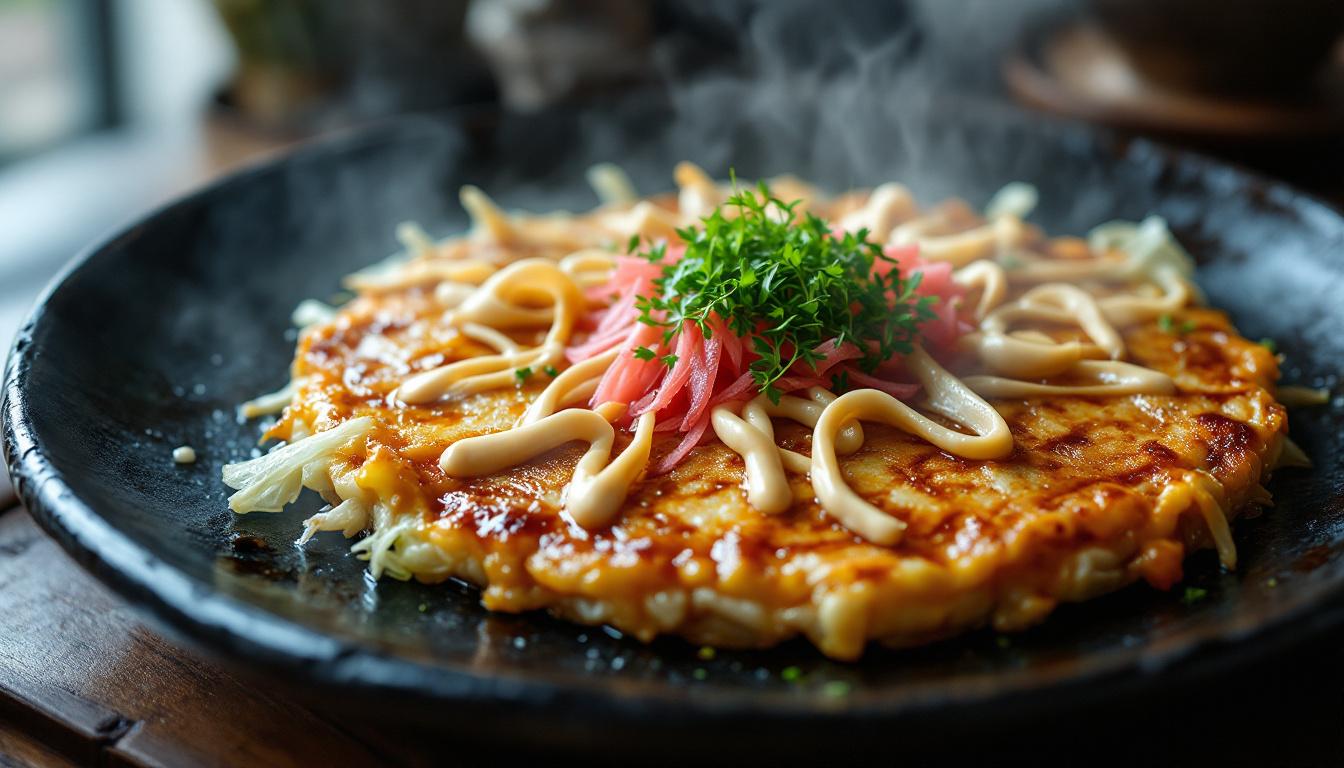I first discovered okonomiyaki during a late-night exploration of Osaka’s Dotonbori district. Amid the neon lights, I found myself at a hole-in-the-wall spot where generations of one family had perfected their recipe. What captivated me wasn’t just the theatrical sizzle as the batter hit the hot teppan, but how this “as-you-like-it pancake” represents Japanese home cooking at its most adaptable and satisfying. The dance of bonito flakes atop the finished dish seemed to whisper, “this is where tradition meets joy.”
The Story
Okonomiyaki evolved from humble beginnings as a simple wheat cake during the Edo period to become an essential comfort food after WWII when rice was scarce. The Osaka-style version—where all ingredients are mixed into the batter—represents the original grandmother’s recipe that I’ve adapted here. What makes this dish special is its perfect balance of textures: cabbage provides subtle crunch, nagaimo (mountain yam) creates ethereal fluffiness, while tenkasu (tempura scraps) adds unexpected pockets of crisp delight.
Ingredients Spotlight
For 4 authentic Osaka-style okonomiyaki:
- 100g (¾ cup) cake flour or all-purpose flour
- 75ml (⅓ cup) dashi stock (the soul of umami depth)
- 100g (3.5oz) grated nagaimo (Japanese mountain yam)
- 150g (5oz) green cabbage, finely chopped and well-drained
- 2 large eggs
- 1 tbsp tenkasu (tempura scraps)
- 1 tsp beni shoga (red pickled ginger)
- 2 scallions, thinly sliced
- 100g (3.5oz) thinly sliced pork belly
- Toppings: okonomiyaki sauce, Japanese mayonnaise, aonori (seaweed flakes), katsuobushi (bonito flakes)
Can’t find nagaimo? Grated potato will work in a pinch, though you’ll sacrifice some fluffiness. No dashi? A light chicken stock with a pinch of MSG creates a similar effect. The heart of okonomiyaki is its adaptability—hence its name, which literally means “grilled as you like it.”
Step-by-Step Guide
1. Sift the flour into a large bowl. Add dashi, 1 tsp milk, 1 tsp soy sauce, and ⅛ tsp baking powder. Whisk in the grated nagaimo until smooth.
2. Critical step: Cover and rest the batter for 30 minutes. This develops the glutens and improves the rise dramatically. Meanwhile, thoroughly drain your chopped cabbage—excess moisture is the enemy of crispy okonomiyaki.
3. Fold the eggs, tenkasu, beni shoga, and scallions into your rested batter. Gently incorporate the cabbage last—the mixture should be vegetable-heavy, barely bound by batter.
4. Heat a lightly oiled pan over medium heat (350°F/175°C). Pour one-quarter of your mixture, forming a round ¾-inch thick pancake. Immediately arrange pork belly slices on top.
5. Cook uncovered for exactly 5 minutes until the bottom develops a golden crust. With confidence, flip using two spatulas. Reduce heat to medium-low, cover, and cook 5 minutes more.
6. Flip once more, brush with okonomiyaki sauce while hot, drizzle with mayonnaise, and shower with aonori and katsuobushi. Serve immediately while the bonito flakes still “dance.”
Chef’s Note: The secret to perfect okonomiyaki is controlling moisture at every stage. Drain cabbage thoroughly, don’t rush the flip until the bottom is properly set, and always test doneness with a toothpick—it should come out clean with no raw batter.
Expert Techniques
Professional okonomiyaki chefs never overmix the batter—treat it like you would a delicate pancake. When adding cabbage, use a folding motion rather than stirring to maintain air pockets. For the signature crispy edge, I press the sides gently with a spatula during the first few minutes of cooking.
When cooking for a group, maintain timing by using two pans simultaneously. Between batches, wipe excess oil from the pan with a paper towel—this prevents unwanted greasiness and ensures each pancake gets that perfect golden crust.
Presentation & Pairing Ideas
In Japan, okonomiyaki is often enjoyed with a cold Asahi or Sapporo beer, but I find a crisp Sauvignon Blanc or dry Riesling works beautifully with its complex flavors. For a complete meal, serve alongside simple miso soup and pickled vegetables to cleanse the palate.
For a stunning seasonal variation, try spring okonomiyaki with sweet corn and fresh shrimp, or autumn versions with mushrooms and thinly sliced pork shoulder. Vegetarians can substitute the pork with thinly sliced king oyster mushrooms brushed with soy sauce.
The beauty of okonomiyaki is that it invites personalization—make it yours by experimenting with the fillings while respecting the core technique. Like Japan’s approach to tradition, honor the method while embracing innovation. Your kitchen, your rules—just as the name suggests, make it as you like it! Try your hand at other Japanese-inspired creations like my Matcha Tiramisu for the perfect fusion dessert pairing.
